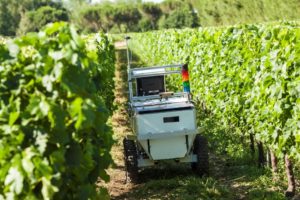Robots and Precision Viticulture
Soon enough vignerons will be assisted by intelligent machines that autonomously roam their vineyards in similar fashion to the Mars Rover or Star Wars’ R2D2. Robots will measure the condition of the vines and grapes and tell the grower which vine needs special TLC.
Today the use of robotics in viticulture may still be at a prototype stage, but many projects are already in the final stage of development such as the VineRobot. It’s an unmanned ground vehicle (UGV) equipped with several non-invasive sensing technologies.

The VineRobot roaming and assessing vineyards.
Traditionally, vineyard husbandry has not been driven by such technology. Since Ancient times, the human eye has been almost the only ‘sensor’ that has steered vineyard management providing a subjective assessment of yield, vegetative growth and plant status for blanket treatments applied to entire vineyards.
A modern tech-dependent approach is ‘precision viticulture’. The new method is based on the underlying premise that, because physical and hydraulic properties of the soil vary over space and time from field to field as well as within fields, farming should be more site specific. In other words: it’s smarter to take care of different patches of a vineyard individually.
This has led to a review of agricultural techniques and a radical new way of growing better quality grapes that at the same time makes more efficient use of energy, water, fertilizers and pesticides while ensuring the preservation of the environment.
However, intensive viticulture management practices to specific vineyard areas applied to achieve the best grape quality and yield in a sustainable manner is only possible once the variables that influence soil, topography, micro-climate and vine growth and grape ripening are appraised.
The VineRobot and its kin will become indispensable for detailed vine diagnosis and data-mining which depends on emerging technologies such as Global Positioning Systems (GPS), meteorological and other environmental sensors, satellite and remote sensing, Geographic Information Systems (GIS), as well as thermal and chlorophyll fluorescence machine vision and imaging.
This article by Georges Meekers appeared first in the Times of Malta, 27th May 2016

